Motor vehicle
| Mini | |
|---|---|
 Mini One (F56) Mini One (F56) | |
| Overview | |
| Manufacturer | BMW (Mini) |
| Also called |
|
| Production | 2001–present |
| Model years | 2002–present |
| Body and chassis | |
| Class | Supermini (B) Sport compact / hot hatch (Cooper S & JCW) |
| Layout | Front-engine, front-wheel-drive |
| Chronology | |
| Predecessor | Mini Austin Metro |
The Mini (stylised as MINI) supermini range, marketed under various names such as Mini Cooper, Mini Hatch, Mini Hardtop, Mini One, and Mini John Cooper Works, are a family of retro-styled three-door hatchback, two-door convertible, and five-door hatchback (since 2014). The range was introduced in July 2001, following the acquisition of the Mini brand by German automaker BMW.
BMW first unveiled the Mini hatch concept car at the 1997 Frankfurt International Motor Show, when the Mini brand was still part of the BMW-owned Rover Group. Developed as a successor to the original Mini, the styling of the concept car was well received by the public and further developed. The new Mini range was launched by BMW in 2001, one year after their sale of the Rover Group in March 2000, and the classic Mini's discontinuation that same year. Under BMW ownership, the brand later grew its line-up by adding larger models such as the Clubman in 2007, the Countryman in 2010, the Paceman in 2012, and the Aceman in 2024.
The second generation was launched in 2006 and the third, adding a longer 4/5-door hatchback, in 2014. A two-door convertible version was added in 2004, followed by its second generation in 2008. With the launch of the fourth generation in 2024, the Mini Hatch has been renamed to Mini Cooper.
BMW also developed several battery electric versions of the Mini, starting with the Mini E in 2009 developed only for field trials, followed by the mass-produced Mini Electric in 2019, and succeeded by the Mini Cooper E/SE in 2023 which uses a dedicated electric vehicle platform.
Mini models under BMW ownership are produced in Cowley, Oxfordshire, United Kingdom at Plant Oxford. Between July 2014 and February 2024, 3-door production was shared with VDL Nedcar in Born, Netherlands. The Mini convertible was only assembled in the Netherlands between 2015 and 2024. From 2024, all next generation combustion engined Mini hatch and convertible production will be centred at Oxford. Since late 2023, the electric Mini Cooper is developed and produced in China at the Spotlight Automotive joint venture facility in Zhangjiagang, Jiangsu.
Initial development
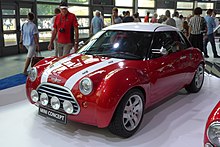
The Mini Hatch (US: Hardtop) was designed by Frank Stephenson, and drew inspiration from the original two-door Mini. Development of the car was conducted between 1995 and 2001 by Rover Group in Gaydon, United Kingdom and BMW in Munich, Germany. During this development phase, there was continual contention between the two design groups, especially concerning the positioning of the car; Rover wanted a straight economy car (which would also replace the Rover 100 Series, which had evolved from the Metro in a 1994 restyle), whilst BMW supported a small, sporting car. Plans for an all-new supermini to replace the Metro in the mid 1990s were shelved when Rover was sold to BMW in January 1994, with the existing Metro model gaining a restyle and a new designation.
The concept was originally unveiled at the 1997 Frankfurt Motor Show at a joint BMW/Rover press conference, with details of the Chrysler/BMW joint venture Tritec engine, and proposed trim levels including Mini Minor (not used) and the Cooper/Cooper S.
Ultimately, BMW prevailed, and in 1999, they assumed control over the entire project following the departure of BMW's CEO, Bernd Pischetsrieder. When BMW sold off Rover in 2000, it retained the Mini project, and moved the planned production site of the car from Rover's Longbridge plant, to BMW's Oxford plant in Cowley, Oxford, England. The team of designers working on the 2001 Mini had finished the full-sized clay mock-up of the Mini in plenty of time for a presentation to the board of directors. However, the American chief designer, Frank Stephenson, realised that the model did not have an exhaust pipe. His short-term solution was to pick up an empty beer can, punch a hole in it, strip off the paint and push it into the clay at the back of the car, which took just a few minutes. The overall design for the mock-up was so good that the board members told him not to change a thing, resulting in the distinctive exhaust tip seen in production cars.
First generation (R50/52/53; 2001)
Motor vehicle| First generation | |
|---|---|
 Pre-facelift (2001–2004) Pre-facelift (2001–2004) | |
| Overview | |
| Model code | R50/53 (Hatch) R52 (Convertible) |
| Production | July 2001–August 2006 (R50/53 hatch) 2004–2008 (R52 convertible) |
| Assembly | United Kingdom: Cowley, Oxfordshire (Plant Oxford) |
| Designer | Frank Stephenson |
| Body and chassis | |
| Body style | 3-door hatchback 2-door convertible |
| Powertrain | |
| Engine |
|
| Transmission | CVT 5/6-speed manual 6-speed automatic |
| Dimensions | |
| Wheelbase | 2,466 mm (97.1 in) |
| Length | 2000–04 Base: 3,627 mm (142.8 in) 2005–06 Base: 3,635 mm (143.1 in) Cooper S: 3,655 mm (143.9 in) |
| Width | 1,689 mm (66.5 in) |
| Height | 2001–04 Base: 1,420 mm (55.9 in) 2001–04 S: 1,427 mm (56.2 in) 2005–06 Base: 1,407 mm (55.4 in) 2005–06 Cooper S: 1,417 mm (55.8 in) Convertible: 1,410 mm (55.5 in) |
| Kerb weight | 1,050 kg (2,315 lb) (Cooper) 1,175 kg (2,591 lb) (Cooper Convertible) 1,215 kg (2,678 lb) (Cooper S) 1,240 kg (2,734 lb) (Cooper S Convertible) |
 Pre-facelift Hatch (2001–2004)
Pre-facelift Hatch (2001–2004)
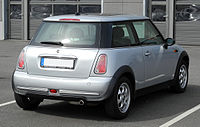 Facelift Hatch (2005–2006)
Facelift Hatch (2005–2006)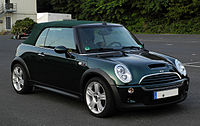
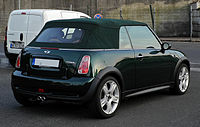 Convertible (2004–2008)
Convertible (2004–2008)
The first new generation Mini Hatch was introduced in July 2001, being the first model launched under the Mini marque after the original Mini was discontinued in the same year. In some European markets, the Mini One was powered by a 1.4-litre (85 cu in) inline-four version of the Tritec engine, but all other petrol powered Minis used the 1.6-litre (98 cu in) version. From 2004 through 2008, the soft-top convertible R52 was made.
Though still considered very compact, the 2001 hatchback's 3.63 m (143 in) length was 58 cm (22.8 in), or 19%, greater than the 3.05 m (10.0 ft) long 1959 Mini. Also, at 3.98 m (157 in), the 2022 five-door hatch stands 68 cm (26.8 in), or some 21%, longer than the original 3.30 m (130 in) Mini estate versions.
There are numerous styling and badging differences between the models, including the Cooper S having a distinctive scoop cut into the bonnet. The Cooper S also has twin exhausts which exit under the centre of the rear valance. The non-S Cooper has more chrome parts than the Mini One and has a single exhaust. The Mini One D has no visible exhaust pipes at all.
In some markets, such as Australia and the US, only the Mini Cooper and Cooper S were offered. Other trim lines and special editions of note, sold in varying markets around the world, are the Mini Seven, Mini Park Lane, Mini Check Mate, and Mini Monte Carlo.
The first generation of the new Mini received a facelift in July 2004 for the upcoming 2005 model year. This was also when the new convertible was introduced; it was not available with the pre-facelift design. Aside from minor design changes (mostly up front, and the steering wheel) and improved equipment, the Rover R65 manual gearbox was replaced with a Getrag five-speed for the MINI One and Cooper.
Models
The vehicles produced during the 2001 to 2006 model years included four hatchback models (UK and some international markets: Hatch, US: Hardtop, other markets just plain Mini): the standard "Mini One", the diesel-engined "Mini One/D", the sportier "Mini Cooper" and the supercharged "Mini Cooper S"; in 2005, a convertible roof option was added to the Mk I line-up. In November 2006, BMW released a redesigned version of the Mini Hardtop as a 2007 model year vehicle.
From March 2002, the Mini was exported to Japan and sold at Japanese BMW dealerships as well as Yanase locations. The car complied with Japanese Government dimension regulations and the introduction of the Mini coincided with several vehicles in Japan that exhibited a retro look that Japanese car companies were offering.
The names Cooper and Cooper S are the names used for the sportier version of the classic Mini, which in turn come from the involvement of John Cooper and the Cooper Car Company. The Cooper heritage is further emphasised with the John Cooper Works (JCW) range of tuning options. The John Cooper Works company also created a higher spec model of the Mini Cooper S, the Mini Cooper S Works. It has a higher volume exhaust and air filter, and uprated brakes and suspension, and different 17-inch (430 mm) wheels from the S models.
A race-prepared version, with rear-wheel drive, called the Mini Cooper S3, competed in the Belcar championship from 2002.
Mini John Cooper Works GP Kit (2006)

The last Mk I variant to be produced using the supercharged Tritec engine was the Mini Cooper S with John Cooper Works GP Kit, a light-weight, quasi-race-prepped John Cooper Works model. Hand-finished by Bertone in Italy, it was offered as a limited-production run of 2000 cars during the 2006 model year, with 444 of those originally intended for the UK market, although ultimately, 459 were sold. The GP has more bolstered Recaro front seats but had no rear seats, which along with reduced sound-deadening, removal of the rear wash-wipe system, optional air-conditioning and radio, and other weight-reduction steps, resulted in a weight saving of around 40 kg (88 lb) compared to a Cooper S.
Mechanically, it has a less restrictive intercooler, recalibrated engine management, high-volume injector nozzles, and a freer-flowing exhaust system. Extra cooling capabilities let the supercharged engine run longer on cooler temperatures for better track performance, rated at 218 PS (215 bhp; 160 kW) at 7100 rpm and 250 N⋅m (184 lb⋅ft) at 4600 rpm of torque.
Specifications

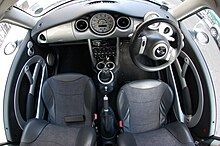
The Mk I Mini One, Cooper and Cooper S all used variants of the Brazilian-built Tritec engine, co-developed by US-based Chrysler and BMW; the Mini One D used a Toyota 1ND-TV diesel engine. In August 2006, BMW announced that future engines would be built in Great Britain, making the car essentially British-built again. Final assembly took place at Cowley, Oxford, and the body pressings were made in nearby Swindon at BMW's Swindon Pressings subsidiary.
All models used a transversely-mounted four-cylinder engine driving the front wheels. The wheels are pushed to the corners of the body to improve handling. The styling of the car, like that of the Volkswagen New Beetle, is a retro design that is deliberately reminiscent of the original Mini. The retro styling retains other classic Mini touches such as contrasting roof colours, optional bonnet stripes, optional rally lights, and black trim around the wheel arches and rocker panels that mimic the wide wheel flares found on many classic Minis.
The Mini One and Mini Cooper were available with a ZF VT1F continuously variable transmission or with a conventional Midlands (Rover R65) 5-speed manual transmission (model years 2002–2004); the latter was replaced with a Getrag 52BG 5-speed unit for the remainder of the Mk I production (2005–2006). The Cooper S came with a 6-speed Getrag G285 manual or an Aisin 6F21WA/TF60SN fully automatic transmission with paddle shifters. The gear ratios of the 6-speed Getrag manual transmission were changed from July 2004 production and onwards.
All Minis had a drive by wire electronic throttle, anti-lock brake electronic brakeforce distribution, and BMW Cornering Brake Control. Stability options were BMW's ASC traction control system and DSC electronic stability control, to improve control and handling in adverse conditions.
The addition of a supercharger to the Mk I Cooper S required that the battery be relocated into the rear of the car – leaving no room for a spare tyre, so the S models came with run-flat tyres.
Second generation (R56/57; 2006)
Motor vehicle| Second generation | |
|---|---|
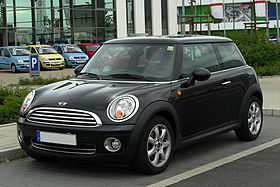 Mini Cooper (R56; Germany) Mini Cooper (R56; Germany) | |
| Overview | |
| Model code | R56 (Hatch) R57 (Convertible) |
| Production | July 2006–November 2013 (Hatch) 2009–2015 (Convertible) |
| Assembly | United Kingdom: Cowley, Oxfordshire (Plant Oxford) |
| Body and chassis | |
| Body style | 3-door hatchback 2-door convertible |
| Powertrain | |
| Engine | |
| Transmission | 6-speed manual / automatic |
| Dimensions | |
| Wheelbase | 2,467 mm (97.1 in) |
| Length | 2007–2010: 3,698 mm (145.6 in) 2007–2010 S: 3,713 mm (146.2 in) 2011–2014: 3,729 mm (146.8 in) |
| Width | 1,684 mm (66.3 in) |
| Height | 1,407 mm (55.4 in) |
| Kerb weight | 1,150 kg (2,535 lb) (Cooper) 1,210 kg (2,668 lb) (Cooper S) |
BMW introduced an all-new, second generation of the Hardtop/Hatch Mini model in November 2006, on a re-engineered platform incorporating many stylistic and engineering changes. It uses the Prince engine, the architecture of which is shared with PSA Peugeot Citroën and is designed to be more cost-effective and fuel-efficient, and is manufactured at the BMW Hams Hall engine plant in Warwickshire, Great Britain. The engineering was done in the United Kingdom by BMW Group UK Engineering, in Munich, Germany at BMW Group headquarters, and by other third parties, BMW Group hired Italdesign Giugiaro (IDG) in Turin, to coordinate the engineering, including the development and validation of the body, structure and chassis of the new Mini. Key Production Associates from affected areas in the assembly process at Plant Oxford were seconded to IDG for the duration of the build to ensure a smooth integration of the new model back in Oxford.
Initially launched in the Cooper and Cooper S trim levels; the range was completed in 2007 with the Mk II Mini One. An economical version called the First was added in 2009. From April 2007 a diesel was available badged as the Cooper D, which was supplemented in 2010 by the lower powered One D and in January 2011 with a new 2.0 L diesel badged as the Cooper SD.
The second generation was again offered in Japan at Japanese BMW locations 24 February 2007, and it continued to be in compliance with Japanese Government dimension regulations which supported sales of both the hatchback and the convertible.
The second generation Convertible was unveiled at the Detroit Auto Show and the Geneva Motor Show as a 2009 model-year vehicle (first available for sale on 28 March 2009). The model has a device, marketed as the "Openometer", which records the number of minutes the vehicle has operated with its roof retracted.
Design
 Hatch (pre-facelift)
Hatch (pre-facelift)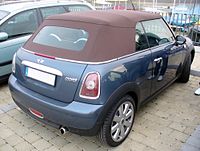 Cabrio (pre-facelift)
Cabrio (pre-facelift) Interior
Interior
Though the Mk II has a familiar look, every panel on the new car was changed from the previous model. New pedestrian impact safety requirements lead to an overall length increase by 60 millimetres (2.4 in) and the bonnet raised, to create more space for the front end to yield in case of impact. Also, the indicators were moved up, integrated in the headlight units. The headlight units are now fixed inside the front quarter panels, rather than being integrated with the previous clamshell bonnet, so that they are no longer raised up with the opening bonnet. This was necessitated by United States law, requiring all essential lighting to henceforth be mounted to fixed, non-movable parts of a vehicle.
The car has a restyled grille and larger rear light clusters. The Cooper S retains the bonnet scoop in order to keep an association with the outgoing model – although the relocation of the intercooler to the front of the engine means that the scoop is now purely decorative. In addition, the Cooper S no longer has the battery located under the boot floor, instead being found in the more conventional location under the bonnet. The C-pillars are no longer encased in glass and have been shaped to improve aerodynamics and to reduce the tendency for dirt to accumulate on the back of the car. Much criticised for the lack of rear legroom, Mini added more space for rear passengers by creating sculpted cut-outs in the rear of the front seats. An engine start button replaces the conventional ignition key and, with the optional 'Comfort Access', the car may be unlocked with a button on the door handle when the key is brought close to the car.
Technical specifications
The Cooper and Cooper S models offer a new rear axle and aluminium components to reduce the car's weight; and a Sports kit option comprising harder springs, damper and anti-roll bars is offered with both variants. Another key difference is the introduction of an upgraded electric power steering system, the sharpness of which can be increased by pressing a "Sport" button in front of the gear lever (both auto and manual); additionally, the "Sport" button adjusts the response of the accelerator, and in conjunction with automatic transmission, also allows the engine to rev almost to the redline before changing gear.
In the Cooper model, the W11 Tritec four-cylinder engine was replaced with a 120 PS (88 kW) 1.6-litre Prince engine incorporating BMW's Valvetronic infinitely variable valve lift, developed on and with Peugeot's core engine. It has been reported in road tests that this takes the car from 0–100 km/h in a claimed 9.1 seconds (0–60 mph: 8.5 seconds) and has a top speed of 201 km/h (125 mph). Fuel economy of 48.7 miles per imperial gallon (5.80 L/100 km; 40.6 mpg‑US) on the combined cycle is nearly 8 miles per imperial gallon (6.7 mpg‑US) better. The more powerful 175 PS (129 kW) Cooper S replaces the supercharger with a new twin scroll turbocharger N14 DOHC motor in the interests of efficiency, and has petrol direct injection; consequently, this engine version does not have Valvetronic. This engine also has an "overboost" function which temporarily raises the torque by 20 N⋅m (15 lbf⋅ft) under hard acceleration. As a result, 0–100 km/h is covered in a claimed 7.1 seconds (0–60 mph: 6.7 seconds), and top speed is 230 km/h (140 mph). It achieves similar improvements in fuel economy to the Cooper, returning 40.9 mpg‑imp (6.91 L/100 km; 34.1 mpg‑US) combined. Both engines may be mated to either a 6-speed manual or automatic gearbox. The turbocharged engine is the same (although with some French engineering modifications) as the one in the Peugeot 207 GTi/RC.
In 2011 the Peugeot DV6 (Ford DLD-416) engine was replaced with the 1.6 and 2.0 BMW N47 Diesels.
All Mk II models with optional Dynamic Stability Control (DSC) also include "Hill Assist", which prevents the car from rolling backwards on an incline by holding the brakes for 2 seconds after the driver releases the brake pedal, allowing the driver time to engage the accelerator pedal without the vehicle drifting down-hill. Also included with DSC is hydraulic Emergency Brake Assist (EBA) as opposed to the mechanical system on Minis without DSC. DSC became standard on all Minis from September 2008.
The interior of the Mk II echoes the style of the earlier model, but is in fact a complete redesign. The boot of the new car has an additional 10 litres (2.2 imp gal; 2.6 US gal) of load space. Other changes in design – both visible and otherwise – have contributed to the Mini's recently awarded five stars in the Euro NCAP tests. One example is the higher front bonnet, which now complies with the European pedestrian collision regulations.
Breakdown statistics reported by the German Automobile Club (ADAC) in May 2010 placed the Mini at the top of the small car class in respect of the low break-down rates achieved for cars aged between 0 and 4 years, narrowly beating the Ford Fusion and Mitsubishi Colt.
Model range
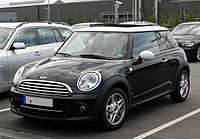
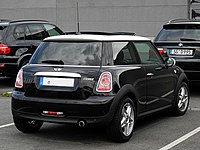 Hatch (facelift)
Hatch (facelift)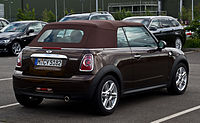 Cabrio (facelift)
Cabrio (facelift)The Mk II range was launched with the One, Cooper and Cooper S derivatives. In July 2009, a new budget version called Mini First was added, 50 years after the launch of the original car. Introduced with a base MSRP of £10,950, It had a similar, but lower output 1.4L 75 PS (55 kW) engine to the One, but with no automatic option. The 1.4L engine was replaced by a 1.6L version, producing the same 75 PS in 2010. The First preempted the launch of the One Minimalism by including the Mini Minimalism technologies. In January 2010 the Mini One Minimalism was announced, which was available in two states of tune depending on the market: (75 PS (55 kW) and 98 PS (72 kW)). The model was marketed as a more environmentally friendly option with low 119 grams (4.2 oz) per kilometre carbon dioxide (CO2) helped by low resistance tyres and flush wheel trims, and included the Minimalism technologies previously excluded from the Mini One.
In spring 2011, a new diesel Mini Cooper SD was launched. With a new four-cylinder 2.0 L turbo diesel engine, it had an output of 145 PS (107 kW) and maximum torque of 305 N⋅m (225 lbf⋅ft) between 1,750 and 2,700 rpm.
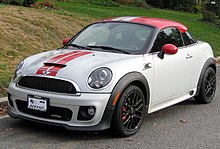
Mini Coupé and Roadster (R58/59; 2011; 2012)
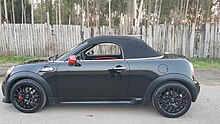
In 2011 and 2012 respectively, the Mini Mk II line-up was expanded with a coupé like the model first shown in 2009, as well as a roadster model. Both are strict two-seater models, which was a first for the Mini brand, derived from the Mini convertible. The roadster's soft-top is either manually or electrically operated, depending on market.
Mini John Cooper Works Challenge (2008–2014)
The Mini John Cooper Works Challenge is a purpose-built race car, based on the R56 Hardtop, and manufactured in the BMW Motorsport factory located in Munich. The Challenge was unveiled in 2007 at the Frankfurt IAA Motor Show.
The BMW Motorsport factory has been responsible for the construction of Formula One and European touring cars for many years. The R56 Challenge has a six-speed manual transmission; 17-inch Borbet wheels with Dunlop control slick racing tyres; John Cooper Works aerodynamic kit including front splitter, rear diffuser, and high-downforce, adjustable rear wing; race-specific AP Racing ABS braking system; KW suspension rebound; height- and camber-adjustable coilover suspension; full roll cage; Recaro bucket seat with six-point safety belt; HANS device; Sparco racing steering wheel; air jack system; and a fully electronic fire extinguishing system.
The car has a 1.6-litre, twin-scroll turbocharged engine that produces 155 kW (211 PS; 208 hp) at 6,000 rpm, along with 261 N⋅m (193 lb⋅ft) of torque. Acceleration from 0–100 km/h (62 mph) is claimed at 6.1 seconds, and braking time from 100–0 km/h is 3.1 seconds.
The car was used for events such as the Australian Mini Challenge, as well as ADAC events, and championships in Britain, Italy and Switzerland. Robbie Davis won the 2013 Pirelli World Challenge.
Mini John Cooper Works (2009–2014)
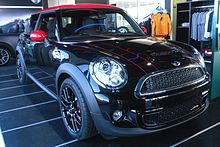
Loosely based on the John Cooper Works (JCW) Challenge car, these are essentially Cooper S vehicles with a higher-output engine; a low-back-pressure exhaust system; a stiffer sport suspension; 17-inch light alloy rims with low-profile, performance tyres; Brembo performance brakes; and BMW's dynamic stability control (DSC) and Dynamic Traction control system (DTC) with Electronic Differential Lock Control (EDLC) as standard equipment. All JCW models are only available with a specific Getrag 6-speed manual transmission, and come with distinctive "John Cooper Works" badging in place of the normal "Cooper S" badging. The JCW vehicles are also factory-built, which further distinguishes them from earlier Mk II Cooper S models with any of the available John Cooper Works accessories (engine and suspension upgrades, aerodynamics kit, etc.) that are dealer-installed. All JCW models achieve the same EPA fuel economy ratings as their Cooper S counterparts.
The engine is rated at 211 PS (155 kW; 208 hp) and 261 N⋅m (193 lb⋅ft); under heavy acceleration, the engine automatically boosts torque output to a peak of 279 N⋅m (206 lb⋅ft). These figures are achieved by reducing compression ratio to 10.0:1, and increasing boost from 0.9 bar (13 psi) to 1.3 bar (19 psi) when compared to the turbocharged engine used in the Cooper S. According to Mini, the JCW Hardtop will sprint to 97 km/h (60 mph) in 6.2 seconds, with the JCW Clubman clocking in at 6.5 seconds; both vehicles top out at 237 km/h (147 mph)
The JCW variants were unveiled in 2008 at the Geneva Auto Show, as 2009 model-year vehicles. Seven cars were entered into the 2011 24 Hours of Nürburgring, coming 4th in class and 34th overall. In 2012, team Partl Motorsport finished in 2nd place in its class with their endurance MINI, finishing in a strong 41st place overall.
The BMW MINI Rallycross Championship, a one-make series, was a support category for the British Rallycross Championship.
Mini John Cooper Works World Championship 50 (2009)
This is a limited-edition (originally planned to be 250 units, then subsequently increased to 500, including 100 units delivered in the UK and 50 in the US) of the John Cooper Works Hardtop. It commemorates the 50th anniversary of the victories by Cooper driver Jack Brabham in the 1959 World Championship of Drivers and by Cooper in the 1959 International Cup for F1 Manufacturers.
The production vehicle was inspired by John Cooper's son, Mike. It includes the John Cooper Works aerodynamics package; John Cooper Works Cross Spoke Challenge light-alloy wheels in Jet Black; specific body paint colours (Connaught Green body with Pepper White roof and bonnet stripes), carbon fibre bonnet scoop, rear diffuser, exterior mirror caps and tailgate handle; and specific interior colour scheme (Carbon Black interior with red knee-rolls, armrests and red stitching on the floor mats, gearshift & handbrake gaiters). The John Cooper signature was provided by "John" Michael Cooper.
The car was unveiled at the 2009 Mini United Festival in Silverstone.
Mini John Cooper Works GP (2012–2014)

The Mini John Cooper Works GP is a limited-edition model run of 2000 units. The GP is a fast road and track focused performance edition, and a celebration before the new Mini variant arrives.
The GP features additional performance, with 218 PS (215 bhp; 160 kW) at 6000 rpm and 280 N⋅m (207 lbf⋅ft) of torque at 2000–5100 rpm from a larger turbo and engine internals, larger front brakes with 6-pot calipers developed by Brembo, coilover suspension developed by Mini and Bilstein, lightweight 17" x 7.5" wheels, semi-slick tyres developed by Kumho specifically for the GP, rear diffuser and carbon kevlar flat under-tray, carbon fiber rear spoiler, 'GP Mode' traction control system, weight saving by the removal of the rear seats and fitting of Recaro sports seats for driver and front passenger.
Styling features include specific vinyl stickers on the bonnet, roof, and door panels, GP badging on the boot lid. Interior includes a new gearknob, leather with red stitching, rear upper strut bar (non-structural) and GP badging on the dash.
All 2000 units were produced in the same specification, with the only option from new being an all-weather tyre, rather than the semi-slick tyre developed by Kumho. Left and right hand drives of this model exist.
Special editions
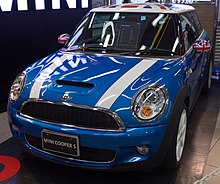
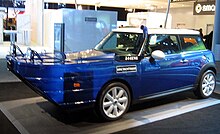
The old tradition of producing special, limited-edition Minis was also continued with the new Mini. For example, the Mini Monte Carlo, recently launched in Singapore, is a tribute to the old Mini Cooper Monte Carlo, itself a limited edition Mini to celebrate Paddy Hopkirk's return to the Monte Carlo Rally 30 years after his original win.
To celebrate the 50th anniversary of the Mini brand, two models were released in 2009: the Mini 50 Mayfair and the Mini 50 Camden.
Also from 2009, thermochromatic, 'chameleon'-called paints were offered in Asia and Europe.
London 2012 Olympic games
At the London 2012 Olympic Games, a set of quarter scale remote-controlled Minis delivered throwing equipment, loaded into the car through the sun roof, to the athletes.
In commemoration of Mini being an official partner of Team GB, an Olympic-themed special limited edition Mini Cooper was released, with a white roof featuring the London 2012 Olympic logo, and the London skyline printed on the dash. There were two other special edition Minis that were released at this time: the Bayswater Special Edition and the Baker Street Special Edition.
Third generation (F55/56/57; 2013)
Motor vehicle| Third generation | |
|---|---|
 2015 Mini Cooper 3-door hatchback 2015 Mini Cooper 3-door hatchback | |
| Overview | |
| Model code |
|
| Production | November 2013–2024 (Hatch) 2015–2024 (Convertible) |
| Model years | 2014 – 2024 |
| Assembly | United Kingdom: Cowley, Oxfordshire (Plant Oxford) Netherlands: Born (VDL Nedcar) |
| Designer | Stefan Göppel |
| Body and chassis | |
| Body style | 3-door hatchback 5-door hatchback 2-door convertible |
| Platform | BMW UKL1 |
| Powertrain | |
| Engine | |
| Electric motor | 135 kW (181 hp) Synchronous Electric Motor (Cooper SE) |
| Transmission | |
| Dimensions | |
| Wheelbase | 2,495 mm (98.2 in) 2,567 mm (101.1 in) (5-door) |
| Length | 3,821 mm (150.4 in) 3,982 mm (156.8 in) (5-door) |
| Width | 1,727 mm (68.0 in) |
| Height | 1,414 mm (55.7 in) 1,425 mm (56.1 in) (5-door) |
| Kerb weight | 1,160–1,295 kg (2,557–2,855 lb) |
| Chronology | |
| Predecessor | Mini Coupé and Roadster (F57) |
The third generation Mini was unveiled by BMW in November 2013, with sales starting in the first half of 2014. The new car is 98 mm longer, 44 mm wider, and 7 mm taller than the outgoing model, with a 28 mm longer wheelbase and increases in track width of +42 mm (front) and +34 mm (rear). The increase in size results in a larger interior and a boot volume increase to 211 litres.
Six all-new engines are offered for this Mini, four petrol and two diesels: two models of a 1.2 litre three-cylinder petrol with either 75 PS or 102 PS, a 1.5 litre 3-cylinder petrol with 136 PS (BMW B38 engine), a 2.0 litre four-cylinder petrol (BMW B48 engine) that produces 192 PS for the Cooper S, and a 1.5 litre 3-cylinder diesel (BMW B37 engine) in two levels of power output: 95 PS and 116 PS (Cooper D), and a 2.0 litre turbo-diesel inline-four (BMW B47 engine) that produces 170 PS (Cooper SD). These engines are mated with a choice of either a 6-speed manual, a 6-speed automatic, or a 6-speed sports automatic gearbox.
MINI has also released an all-new model called the MINI 5-door (known as the 4-door in US, model code F55). It is marketed as a 5-door version of the new third generation Hatch. The base MINI 5-door is 6 in (152 mm) longer and 190 lb (86.2 kg) heavier than the 3-door MINI Hatch models, with similar performance characteristics and greater interior and cargo space. The 5-door is exclusively assembled at Plant Oxford with additional tooling for the body sides, new equipment in the wax sealing line in the plant’s paintshop to accommodate the extra door and differences in the shaping of the rear of the car. Plant Swindon produces the new rear door cells in the sub-assembly line with additional roof and panel tooling in the press shop.
The 3-door Mini with an automatic transmission will reach 0–97 km/h (0–60 mph) in 7.3 seconds for the 1.5L 3-cylinder petrol model and in 6.4 seconds with the 2.0L 4-cylinder petrol engine.
The Cooper S soon was joined by the higher performing John Cooper Works model in 2015.
In 2018, the Life Cycle Impulse (LCI), the 6-speed Steptronic torque-converter were replaced by a 7-speed dual-clutch transmission in all models but the Cooper SD and JCW, with the latter now fitted with an 8-speed Steptronic auto. These changes allow for improved efficiency and better emissions test results in the WLTP cycle, as well as marginally improved performance.
A battery-electric version, the Mini Electric (aka Cooper SE), was launched in 2020.
In 2021, the second Life Cycle Impulse (LCI) was released. The model received both optical and technical updates. The front and rear bumpers were redesigned, union jack taillights now came as standard as well as LED headlights. The interior updates are limited to a new steering wheel design and additional ambient lighting under dashboard trim pieces and in the door trims. The petrol-powered cars are fitted with a particle filter which led to a 10 horsepower decrease in power output for the B48-powered Cooper S.
Design
The shape is slightly more rounded than the one it replaces, in order both to improve the car's aerodynamic efficiency and to enhance pedestrian protection in the event of accidents. It has a much longer overhang and higher bonnet. This latest model rides on BMW's all new UKL platform that underpins the new BMW 2 Series Active Tourer.
Criticisms of the design of the F56 MINI Cooper have focused upon the extruded and complex design of the front bumper in Cooper S and JCW variants, as well as the larger front overhang and oversized tail lamps. Further criticism has also centred upon the overstyled nature of the exterior design.
The Mini is also the first in its segment to offer LED headlamps for its main and dipped beams as an option.
With its larger exterior dimensions, the all-new Mini provides more space for its four occupants and luggage, with enhanced shoulder space and larger footwells. Boot volume has been increased by more than 30% to 211 litres. When using only 2 seats in the car, boot capacity increases up to 731 litres.
The dashboard retains its instrument layout, but adds a new instrument binnacle on the steering column for the speedometer, tachometer, and fuel gauge. The central instrument display now houses a four-line TFT display with the option to upgrade to an 8.8 inch screen for navigation and infotainment functions.
Mini John Cooper Works GP (2020)
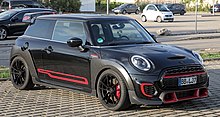
The third generation of the Mini John Cooper Works GP first appeared as a concept car in the IAA Cars 2017 with a track ready race-track character. The stripped-out interior included a roll cage and only a pair of racing seats (back seats were absent) with five-point racing harnesses. Outside, both front and rear wheels were covered by prominent wings (especially in the rear). A unique rear spoiler and centrelock 19" wheels were other features of the track-focused hot hatch. In June 2019, a tweet was posted showing the Nürburgring time of 07:56:69 molded into the plastic trim of the dashboard.
The actual production model was revealed in November 2019, retaining some characteristics from the concept such as a very similar rear spoiler and wings (this time smaller in the rear). The wider track and wider wheels required wider wings. Other more extreme racing features (for a street car) like the centrelock wheels and five-point harnesses were removed, although the back seats were kept absent. The suspension is even stiffer and lower than a standard JCW and the turbocharger was redesigned for more boost pressure. The transmission is automatic only because there was no manual transmission available that could withstand the power and torque from the engine. The Nürburgring time on the dashboard was replaced by the individual production number (this same number appears on the front wings).
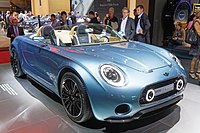 Mini Superleggera Vision Concept
Mini Superleggera Vision Concept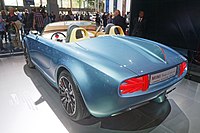
The 2.0 litre turbocharged engine outputs 225 kW (302 hp) and 450 N⋅m (332 lb⋅ft) of torque. The 0–100 km/h is 5.2 s and the top speed is 265 km/h (165 mph) (not cut off). As of release time, the third generation of the Mini JCW GP is the fastest and most powerful street car Mini has ever produced.
Production was limited to 3,000 units, with a MSRP of $44,900 (USD).
Mini Superleggera Vision Concept
In 2014 Mini revealed a Mini Superleggera Vision Concept for a possible new roadster, in collaboration with Carrozzeria Touring Superleggera at the Concorso d'Eleganza Villa d'Este.
Gallery
-
 3-door hatchback (rear)
3-door hatchback (rear)
-
 3-door hatchback John Cooper Works
3-door hatchback John Cooper Works
-
 5-door hatchback
5-door hatchback
-
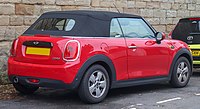 2-door convertible
2-door convertible
-
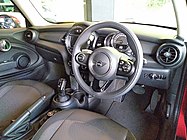 Interior (first facelift)
Interior (first facelift)
-
 2-door convertible (first facelift)
2-door convertible (first facelift)
-
 Rear view with the Union Jack rear lights
Rear view with the Union Jack rear lights
-
 Union Jack rear lights lit-up
Union Jack rear lights lit-up
-
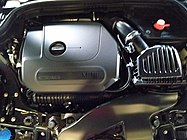 2.0L BMW B48 TwinPower Turbo petrol engine in a Mini Cooper S
2.0L BMW B48 TwinPower Turbo petrol engine in a Mini Cooper S
-
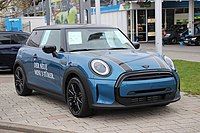 3-door hatchback (second facelift)
3-door hatchback (second facelift)
-
 Rear view
Rear view
-
 Second facelift with JCW optical package
Second facelift with JCW optical package
-
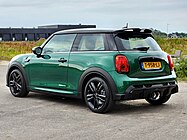 Second facelift with JCW optical package
Second facelift with JCW optical package
-
 Interior of the second facelift
Interior of the second facelift
Powertrains
| Model | Fuel Type | Displacement | Cylinders | Transmission | Power | Torque | Top Speed | Acceleration, 0–62 mph (0–100 km/h) | Kerb weight |
|---|---|---|---|---|---|---|---|---|---|
| One First | Petrol | 1.2 L (1,198 cc)
LCI (2018–) 1.5 L (1,499 cc) |
3 | 6-speed manual | 55 kW (75 PS; 74 hp) | 150 N⋅m (111 lb⋅ft) | 165 km/h (103 mph) | 13.4s | 1,165 kg (2,568 lb) |
| One | 1.2 L (1,198 cc)
LCI (2018–) 1.5 L (1,499 cc) |
3 | 6-speed manual
LCI (2018–) 6-speed manual |
75 kW (102 PS; 101 hp) | 180 N⋅m (133 lb⋅ft) LCI (2018–) 190 N⋅m (140 lb⋅ft) |
195 km/h (121 mph) | 9.9 s | 1,165 kg (2,568 lb)
| |
| Cooper | 1.5 L (1,499 cc) | 3 | 6-speed manual
LCI (2018–) 6-speed manual |
100 kW (136 PS; 134 hp) | 220 N⋅m (162 lb⋅ft) | 210 km/h (130 mph) | 7.9 s | 1,160 kg (2,560 lb)
| |
|
Cooper S |
2.0 L (1,998 cc) | 4 |
6-speed manual LCI (2018–) 6-speed manual |
141 kW (192 PS; 189 hp) | 280 N⋅m (207 lb⋅ft) | 235 km/h (146 mph) | 6.8 s | 1,205 kg (2,657 lb)
| |
| John Cooper Works | 2.0 L (1,998 cc) | 4 |
6-speed manual LCI (2018–) 6-speed manual |
170 kW (231 PS; 228 hp) | 320 N⋅m (236 lb⋅ft) | 246 km/h (153 mph) | 6.3 s | 1,205 kg (2,657 lb)
| |
| JCW GP | 2.0 L (1,998 cc) | 4 | 8-speed auto | 225 kW (306 PS; 302 hp) | 450 N⋅m (332 lb⋅ft) | 265 km/h (165 mph) | 5.2 s | 1,255 kg (2,767 lb) | |
| One D | Diesel | 1.5 L (1,496 cc) | 3 |
6-speed manual |
70 kW (95 PS; 94 hp) | 220 N⋅m (162 lb⋅ft) | 190 km/h (118 mph) | 11.6 s | 1,190 kg (2,620 lb) |
| Cooper D | 1.5 L (1,496 cc) | 3 |
6-speed manual LCI (2018–) 6-speed manual |
85 kW (116 PS; 114 hp) | 270 N⋅m (199 lb⋅ft) | 205 km/h (127 mph) | 9.2 s | 1,210 kg (2,670 lb)
| |
| Cooper SD | 2.0 L (1,995 cc) | 4 |
6-speed manual LCI (2018–) |
125 kW (170 PS; 168 hp) | 360 N⋅m (266 lb⋅ft) | 227 km/h (141 mph) | 7.2 s | 1,250 kg (2,760 lb)
| |
| Cooper SE | Electric | 32.6-kWh battery | 1-speed Automatic with single-stage configuration and integrated differential | 135 kW (184 PS; 181 hp) | 270 N⋅m (199 lb⋅ft) | 150 km/h (93 mph) | 7.3 s |
Fourth generation (J01/F65/66/67; 2023/2024)
Battery electric (J01; 2023)
Motor vehicle| Fourth generation | |
|---|---|
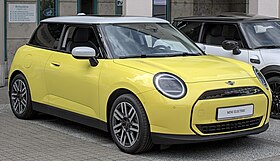 Mini Cooper SE (J01) Mini Cooper SE (J01) | |
| Overview | |
| Model code | J01 |
| Production | October 2023 – present |
| Model years | 2025 |
| Assembly | China: Zhangjiagang, Jiangsu (Spotlight Automotive) |
| Body and chassis | |
| Body style | 3-door hatchback |
| Layout | Front-motor, front-wheel-drive |
| Related | Mini Aceman |
| Powertrain | |
| Electric motor | Permanent magnet synchronous |
| Power output |
|
| Battery |
|
| Dimensions | |
| Wheelbase | 2,526 mm (99.4 in) |
| Length | 3,858 mm (151.9 in) |
| Width | 1,756 mm (69.1 in) |
| Height | 1,460 mm (57.5 in) |
| Kerb weight | 1,540–1,605 kg (3,395–3,538 lb) |
| Chronology | |
| Predecessor | Mini Electric |
The fourth-generation battery electric Mini hatchback was unveiled on 1 September 2023. Exclusively available as a 3-door hatchback, the model is marketed as the Mini Cooper regardless of the trim level. European sales started in 2024, and in North America it will be available as a 2025 model year vehicle. A heavily refreshed version of the third-generation Mini Hatch is sold alongside this generation since 2024 as the internal combustion engined (ICE) option. The J01 Cooper is available in two configurations, Cooper E and Cooper SE.
The model was developed and produced by Spotlight Automotive, a joint venture between BMW Group and Great Wall Motor, at a newly built manufacturing plant in Zhangjiagang, Jiangsu, China. The first mass-produced units rolled off from the plant on 14 October 2023. Mini’s Oxford Plant in Oxford, England, is set to begin production of the electric J01 in 2026.
The Cooper receives a simplified interior layout, where a fully circular OLED touchscreen in the centre with a 240 mm (9.45 in) diameter based on the OS9 operating system becomes the only physical display in the interior.
Powertrain
| Model | Battery | Power | Torque | Range | Charging rate | 0–100 km/h (0–62 mph)(official) | Layout | Cal. years |
|---|---|---|---|---|---|---|---|---|
| Cooper E | 40.7 kWh | 135 kW (181 hp; 184 PS) | 290 N⋅m (29.6 kg⋅m; 214 lb⋅ft) | 305 km (190 mi) | 7.3 seconds | Single motor FWD | 2024 | |
| Cooper SE | 54.2 kWh | 160 kW (215 hp; 218 PS) | 330 N⋅m (33.7 kg⋅m; 243 lb⋅ft) | 402 km (250 mi) |
|
6.7 seconds |
Internal combustion (F65/66/67; 2024)
Motor vehicle| Fourth generation | |
|---|---|
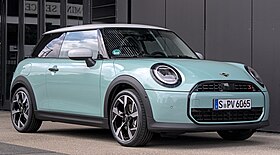 Mini Cooper S 3-door Mini Cooper S 3-door | |
| Overview | |
| Model code |
|
| Production | 2024–present |
| Model years | 2025–present |
| Assembly | United Kingdom: Cowley, Oxfordshire (Plant Oxford) |
| Body and chassis | |
| Body style |
|
| Platform | BMW UKL1 |
| Powertrain | |
| Engine | |
| Transmission |
|
| Dimensions | |
| Wheelbase | 2,495 mm (98.2 in) |
| Length | 3,876 mm (152.6 in) |
| Width | 1,744 mm (68.7 in) |
| Height | 1,432 mm (56.4 in) |
| Kerb weight | 1,357 kg (2,991 lb) |
The UK-produced, internal combustion engined (ICE) version of the Cooper is extended into the fourth-generation. Developed under the model code F66 (3-door), the car debuted online in 6 February 2024. It heavily based on the previous generation model, while introducing updated styling with similar design elements from the battery electric J01 Cooper.
The F66 Cooper is available in two trims, namely the Cooper C and Cooper S. The Cooper C uses a 1.5-litre three-cylinder turbocharged engine, producing 156 PS (154 hp; 115 kW) of power and 230 N⋅m (23.5 kg⋅m; 170 lb⋅ft) of torque. The Cooper S uses a more powerful 2.0-litre four-cylinder turbocharged engine producing 204 PS (201 hp; 150 kW) of power and 300 N⋅m (30.6 kg⋅m; 221 lb⋅ft) of torque. Both engines are paired with a 7-speed dual-clutch transmission.
-
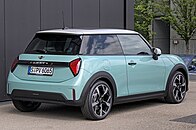 Rear view
Rear view
-
 Mini Cooper S 3-door JCW-Trim
Mini Cooper S 3-door JCW-Trim
-
 Interior
Interior
-
 Mini Cooper Sport C 3-door
Mini Cooper Sport C 3-door
-
 Mini Cooper Sport C 3-door
Mini Cooper Sport C 3-door
-
 Mini Cooper Sport C 3-door
Mini Cooper Sport C 3-door
-
 Mini Cooper C 5-door
Mini Cooper C 5-door
-
 Rear view
Rear view
Reception
The Mini Cooper/Cooper S (2001–2006) won the North American Car of the Year award in 2003. The car won the 2006 car of the year at the "Das Goldene Lenkrad" awards in Germany. MotorPress.ca awarded the F56 MINI JCW with their "Driver's Car Award" and "Top Pick" award giving it a rating of 8.3 out of 10, praising its driving characteristics and engine. Fifth Gear awarded the Cooper S their Best Small Car of 2006 award.
The Mini brand enjoyed paradoxically strong sales and customer loyalty in the US, while at the same time being rated worst for problems found in the JD Power survey. In 2009, Mini ranked last, 37 out of 37 brands, in the JD Power Initial Quality Survey, having landed second to last the previous year. The survey gives the same weight to problems from something being broken, and problems due to the car owner finding them difficult to use, unfamiliar, or confusing. The quirky controls found in Minis, such as non-standard windscreen wiper or interior lighting switches, were counted both as "problems" that hurt Mini's ranking in the Initial Quality Survey, and also as distinguishing "idiosyncrasies" that, over time, made owners grow to love the cars. This contributed to brand loyalty and relatively strong sales, and expanding the number of US Mini dealerships, in the midst of the 2008 recession and automotive industry crisis of 2008–10.
Consumer Reports ranked Mini as the least reliable car brand in 2013, saying that, "less-expensive European brands are having more problems", perhaps due to cost-cutting at the expense of reliability. In 2015, Consumer Reports awarded the 2006–2012 Mini Cooper S the title 'Worst Used Car', saying that while it was "cute and delightfully entertaining", the repair frequency was "heartbreaking" because the magazine's surveyed owners reported problems in the areas of "engine major, engine minor, engine cooling, fuel system, body integrity, and body hardware have issues at an alarming rate".
References
- "MINI hatchback review - Engines, drive & performance 2024". Carbuyer. Retrieved 26 February 2024.
- "The next all-new Mini will be called the Mini Cooper and it'll arrive in 2024". 10 March 2023.
- "Mini voor Amerika ook uit Nederland". TMG Landelijke Media B.V., Amsterdam (Autovisie). 12 March 2014. Retrieved 1 June 2017.
- Last VDL Mini"Last VDL Mini produced at Born". 16 February 2024.
- Mini Plant Oxford 600m investment"Mini Plant Oxford £600m investment".
- ^ Paternie, Paterick C. (2002). Mini. MBI Publishing Company LLC. ISBN 0-7603-1157-9.
- Chadderton, Paul (17 September 1997). "Mini makes its move". Auto Express (466): 13.
- ^ "Anglo-German Success". The Unofficial Austin-Rover Web Resource. Archived from the original on 17 January 2008. Retrieved 29 January 2007.
- Roebuck, Bill. "2002 Mini Cooper Road Test: Mini Magic". Car Test. Retrieved 9 July 2011.
He picked up an empty beer can, cut it in half, stripped off the paint, polished the metal, and glued it to the back of the car. It took just a few minutes.
- Schifsky, Chuck (August 2001), "2002 Mini Cooper", Motor Trend, pp. 60–
- Lassa, Todd (September 2004), "Capitation and adjectivication: 2005 Mini cooper convertible", Motor Trend, vol. 56, no. 9, pp. 39–
- "2003 Mini Cooper S: instant fun—just add driver and premium fuel", Motor Trend, pp. 148–, April 2005
- "Mini Cooper S Convertible (2004) full detailed specifications listing and photo gallery", Automobile Catalog, archived from the original on 6 January 2012, retrieved 25 August 2016
- "MINI Timeline 2001 - 2021".
- "Evo Magazine December 2007". Evo.co.uk. 6 December 2007. Retrieved 25 June 2011.
- Randall, Martynn (2005). Mini Owners Workshop Manual July 2000 to 2005 (Y to 05 reg) Petrol. Sparkford: Haynes.
- Mini Cooper: service manual, Mini Cooper, Mini Cooper S, 2002, 2003, 2004. Cambridge, Massachusetts: BentleyPublishers. 2004. ISBN 0-8376-1068-0.
- Adams, Keith (18 August 2011). "Buying guide: Mini 2001–2007". AROnline. Retrieved 20 August 2014.
- "Introducing the 2007 Mini Cooper S". MC2 Magazine. No. 5. Barry Brazier. November 2006.
- ^ Anderson, Gary; Racine, Don (1982). Motoring: Getting the Maximum from Your New Mini. Los Altos, California: Enthusiast Publications. ISBN 0-9765780-0-X.
- "2002 Qvick Mini Cooper S3". SuperCars.net. 28 December 2015.
- Suttie, Alisdair (1 May 2014). "Mini Cooper S (R53): PH Buying Guide". PistonHeads. Retrieved 5 October 2016.
- MINI Cooper Service Manual; Bentley Publishers, a division of Robert Bentley, Inc. 2010; Pgs. 200–2 – 200–3
- "RealOEM.com – Online BMW Parts Catalog". www.realoem.com.
- "Everything You Need to Know Before Buying a Mini Cooper S". 29 July 2016.
- Mundy, Tim (2004). You & Your New Mini: Buying, Enjoying, Maintaining, Modifying. Somerset: Haynes. ISBN 1-84425-028-8.
- "Mini Cooper review – Retro hot hatch is as fun as ever". Evo. Archived from the original on 10 August 2011. Retrieved 10 March 2012.
- "Mini First review". Autocar. 4 August 2009. Retrieved 10 April 2012.
- "Mini One D review". Autocar. 15 December 2010. Retrieved 10 April 2012.
- Nunez, Alex (11 January 2009). "Detroit 2009: Mini Cooper Convertible chills out". Autoblog.com. Retrieved 17 November 2010.
- Joseph, Noah (10 February 2009). "Geneva Preview: Mini drops the top on the JCW cabrio". Autoblog.com. Retrieved 17 November 2010.
- "2009 Mini Convertible Photos and Specs Released". Wot.motortrend.com. Retrieved 17 November 2010.
- ^ "Mini Cooper Specs". JB car pages. Retrieved 21 March 2008.
- "Die ADAC Pannenstatistik 2009". ADAC Motorwelt: 26–27. May 2010.
- "Pannenstatistik – Kleinwagen", ADAC Motorwelt, May 2010, archived from the original on 3 May 2010, retrieved 13 May 2010
- Harley, Michael (17 July 2009). "Mini launches entry-entry-level First Cooper abroad". Autoblog.com. Retrieved 17 November 2010.
- "Mini First 1.6". Autocar. Retrieved 12 February 2024.
- "News & Events – Explore – MINI UK". News & Events – Explore – MINI UK.
- "MINI in 2011: More power, more sportiness, more individuality. Premiere of the MINI Cooper SD with 2.0-litre turbodiesel engine and 105 kW/143 hp – John Cooper Works Pack for the MINI and MINI Convertible – MINI Yours presents the MINI Clubman Hampton special edition". www.press.bmwgroup.com.
- Nunez, Alex (14 August 2007). "Frankfurt Preview: Mini's track-prepped John Cooper Works Challenge". Autoblog.com. Retrieved 17 November 2010.
- "Official Homepage - mini.com". www.minispace.com.
- "MINI – Premium SAVs, 4 door, & 2 Door Cars – MINI USA". MINIUSA.
- "First Drive: 2009 Mini John Cooper Works". Motortrend.com. 26 February 2007. Retrieved 17 November 2010.
- Riches, Erin (4 March 2008). "2009 Mini John Cooper Works: 2008 Geneva Auto Show". Blogs.edmunds.com. Archived from the original on 24 September 2009. Retrieved 17 November 2010.
- "39. ADAC Zurich 24h-Rennen: Official Race Results" (PDF). Archived from the original (PDF) on 27 February 2015. Retrieved 28 April 2012.
- "Official Homepage - mini.com". www.minispace.com.
- "British Rallycross Results – MSA British Rallycross". www.rallycrossbrx.com.
- Paukert, Chris (6 October 2009). "Officially Official: Mini Cooper JCW World Championship 50 details and photos released". Autoblog.com. Retrieved 17 November 2010.
- "2012 MINI John Cooper Works GP". carfolio.com. 13 March 2013. Retrieved 27 July 2018.
- "Limited Edition Mini Monte Carlo". Icars.sg. 6 November 2008. Retrieved 17 November 2010.
- Neff, John (22 May 2009). "Mini 50 Mayfair and 50 Camden celebrate 50 years of tiny, cuddly performance". AOL Autoblog. Retrieved 1 June 2012.
- sgCarMart. "MINI launches Singapore's first chameleon car". sgCarMart.com.
- "New car prices, new car research, auto finance at PriceWheels.com". www.pricewheels.com.
- okokno com (19 August 2012). London Olympics 2012 Remote Control Mini Cooper Retrieving Ball. Retrieved 23 June 2024 – via YouTube.
- "Subscribe to Modern Mini". www.modernmini.co.uk.
- "MINI, PREMIUM MATURITY". Bmwblog.com. 24 May 2014. Retrieved 24 May 2014.
- ^ "Spot the Difference: Mini Reveals New Generation Model". Top Gear Philippines. 20 November 2013. Retrieved 20 November 2013.
- Nagy, Bob (5 June 2014). "2015 Mini Hardtop 4-door: A stretch in size and appeal". Kelley Blue Book. US. Retrieved 5 October 2016.
- "The new MINI 5-door Hatch rolls off the lines at Oxford". BMW Press Group.
- Ramey, Jay (17–31 March 2014). "Mini Grows Up". Autoweek. 64 (7): 42–43.
- "Great Britain: Okay, er ist kein sortenreiner Brite und auch nicht mehr so richtig mini. Dennoch hat sich der neue Mini eine ordentliche Portion jugendlichen Charme bewahrt ... den modernsten Mini aller Zeiten". Auto Motor und Sport. Vol. 04 2014. Stuttgart: Motor Presse Stuttgart GmbH & Co. 2014. p. 25.
- Shah, Vivek (28 December 2015). "MINI Cooper (F56): Overstyle and caricature". Deep Tread. Archived from the original on 19 September 2016. Retrieved 5 October 2016.
- "MINI 3-Door Hatch - Fun-Filled Hatchback Car - MINI UK Official". www.mini.co.uk. Retrieved 8 July 2022.
- Herrmann, Susanne (6 September 2017). "The MINI John Cooper Works GP Concept: Racing without compromise. MINI presents design study at the IAA Cars 2017". BMW Group. Retrieved 23 March 2020.
- Pierce, Will (27 June 2019). "I was really on board for the new Mini GP until I saw the Nürburgring time is on the dash" (Tweet). Retrieved 23 March 2019 – via Twitter.
- Stocksdale, Joel (28 June 2019). "2020 Mini JCW GP has Nurburgring lap time on dashboard | Autoblog". Autoblog. Retrieved 23 March 2020.
- ^ Bode, Matthias; Lampka, Andreas (20 November 2019). "The new MINI John Cooper Works GP". BMW Group. Retrieved 23 March 2020.
- ^ Boeriu, Horatiu (19 November 2019). "World Premiere: MINI John Cooper Works GP with 306 hp and racing DNA". www.bmwblog.com. Retrieved 23 March 2020.
- ^ Stocksdale, Joel (21 November 2019). "2020 Mini John Cooper Works GP: Why there isn't a manual, and more | Autoblog". Autoblog. Retrieved 23 March 2020.
- Cutler, Andrew; Duda, Rob (4 November 2019). "On the way to the starting line: US market pricing announced for the new high-performance Mini John Cooper Works GP". BMW Group. Retrieved 23 March 2020.
- "MINI Superleggera™ Vision – timeless beauty that blends the traditional with the modern". www.press.bmwgroup.com. Retrieved 13 January 2021.
- ^ Batchelor, James. "New MINI 2018 facelift review". Auto Express. Retrieved 7 December 2018.
- Mills, James (20 November 2019). "First ride: 2020 Mini JCW GP | Autocar". Autocar. Retrieved 23 March 2020.
- Golson, Daniel (9 July 2019). "The 2020 Mini Cooper SE Is the First Real Electric Mini". Car and Driver. Retrieved 9 July 2019.
- "2024 Mini Cooper electric hatch revealed". 12 April 2023.
- Pappas, Thanos (8 March 2023). "MINI Cooper EV Will Debut In 2024 With Up To 215 HP And A 240-Mile Range". Carscoops.
- Chilton, Chris (1 September 2023). "2025 Cooper EV Is A Grown-Up Premium Hatch That's More Baby BMW Than Mini". Carscoops. Retrieved 1 September 2023.
- "GWM and BMW Group worked together to push the construction of the spotlight automotive factory". Automotive World. 23 June 2020. Retrieved 1 September 2023.
- "BMW Gets Help From China for First Electric Mini Cooper Platform". Bloomberg.com. 1 September 2023. Retrieved 1 September 2023.
- Chen, Dong Yi (14 October 2023). "New electric MINI Cooper made in China rolled off assembly line, market entry in 2024". CarNewsChina.com. Retrieved 15 October 2023.
- "MINI Plant Oxford goes Electric: £600m investment for all-electric MINI production in the UK". BMW Group.
- "New 2024 MINI Cooper EV unveiled with up to 250 miles of range". Auto Express. Retrieved 1 September 2023.
- Dorian, Drew (25 September 2024). "Tested: 2025 Mini Cooper S Tries to Remain True to Its Roots". Car and Driver.
- https://www.bmwblog.com/2024/02/06/2025-mini-cooper-f66-specs/
- Bridger, Gabriel (8 June 2023). "The 2025 F66 MINI Cooper Family Will Get Only One Transmission Option - MotoringFile". Retrieved 2 September 2023.
- Bridger, Gabriel (27 June 2023). "Preview of The Last Internal Combustion MINI – The F66 2025 MINI Cooper - MotoringFile". Retrieved 2 September 2023.
- Stopford, William (28 March 2024). "2025 Mini Cooper price and specs". CarExpert. Retrieved 26 April 2024.
- Banner, Justin (7 February 2024). "2025 Mini Cooper C and S First Look: The Gas Minis Aren't Going Anywhere". Motor Trend. Retrieved 26 April 2024.
- Robson, Graham (2002). New Mini. Newbury Park, California: Haynes North America. ISBN 1-85960-874-4.
- "Die Sieger des Goldenen Lenkrads (1976–2013)" [The winner of the Golden Steering Wheel (1976–2013)] (PDF). Das Goldene Lenkrad 2013 (in German). Bild am Sonntag und Auto Bild. 12 November 2013. pp. 18–21. Archived from the original (PDF) on 4 March 2016. Retrieved 8 December 2014.
- "2016 MINI John Cooper Works ( JCW )". MotorPress.ca. 8 February 2016.
- Chang, Richard S. (2 July 2009), "Mini Conundrum: Does Quality Matter?", New York Times
- "Mini laughs off last-place quality ranking; It calls some features that may be off-putting quirks instead of problems", ABC News, Associated Press, 28 June 2009, retrieved 25 August 2016
- Woodyard, Chris (29 October 2013), "Consumer Reports: Top 10 most unreliable car brands", USA Today
- "Cars you'd be foolish to buy; Reliability, satisfaction, and test scores knock out these contenders", Consumer Reports, 1 April 2015, retrieved 25 August 2016
External links
| « previous — Mini, a brand of the BMW Group, car timeline, 2001–present | |||||||||||||||||||||||||||||||||||||||||||||||||||||||||||||||||||||||||||||||||||||||||||||||||||||||||||||||||||||||||||||||||||||||||||||||||||||||||||||||||||||||||||||||||||||||||||||||||||||||||||||||||||||||||||||||||||||||||||||||||||||||||||||||||||||||||||||||||||||||||||||||||||||||
|---|---|---|---|---|---|---|---|---|---|---|---|---|---|---|---|---|---|---|---|---|---|---|---|---|---|---|---|---|---|---|---|---|---|---|---|---|---|---|---|---|---|---|---|---|---|---|---|---|---|---|---|---|---|---|---|---|---|---|---|---|---|---|---|---|---|---|---|---|---|---|---|---|---|---|---|---|---|---|---|---|---|---|---|---|---|---|---|---|---|---|---|---|---|---|---|---|---|---|---|---|---|---|---|---|---|---|---|---|---|---|---|---|---|---|---|---|---|---|---|---|---|---|---|---|---|---|---|---|---|---|---|---|---|---|---|---|---|---|---|---|---|---|---|---|---|---|---|---|---|---|---|---|---|---|---|---|---|---|---|---|---|---|---|---|---|---|---|---|---|---|---|---|---|---|---|---|---|---|---|---|---|---|---|---|---|---|---|---|---|---|---|---|---|---|---|---|---|---|---|---|---|---|---|---|---|---|---|---|---|---|---|---|---|---|---|---|---|---|---|---|---|---|---|---|---|---|---|---|---|---|---|---|---|---|---|---|---|---|---|---|---|---|---|---|---|---|---|---|---|---|---|---|---|---|---|---|---|---|---|---|---|---|---|---|---|---|---|---|---|---|---|---|---|---|---|---|---|---|---|---|---|---|---|---|---|---|---|---|---|---|---|---|---|---|---|
| |||||||||||||||||||||||||||||||||||||||||||||||||||||||||||||||||||||||||||||||||||||||||||||||||||||||||||||||||||||||||||||||||||||||||||||||||||||||||||||||||||||||||||||||||||||||||||||||||||||||||||||||||||||||||||||||||||||||||||||||||||||||||||||||||||||||||||||||||||||||||||||||||||||||
| |||||||||||||||||||||||||||||||||||||||||||||||||||||||||||||||||||||||||||||||||||||||||||||||||||||||||||||||||||||||||||||||||||||||||||||||||||||||||||||||||||||||||||||||||||||||||||||||||||||||||||||||||||||||||||||||||||||||||||||||||||||||||||||||||||||||||||||||||||||||||||||||||||||||



